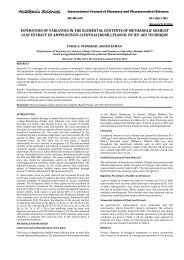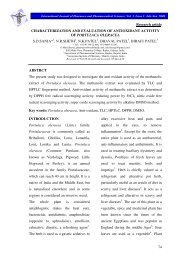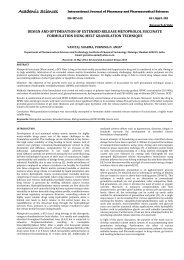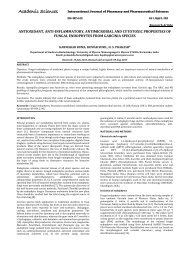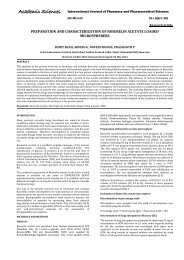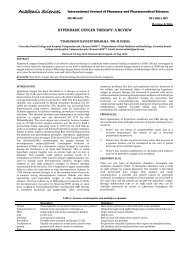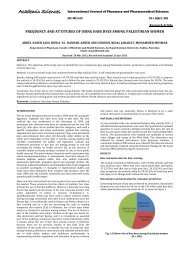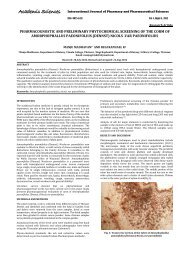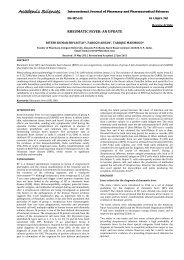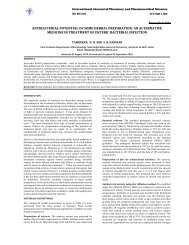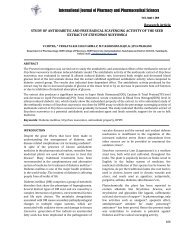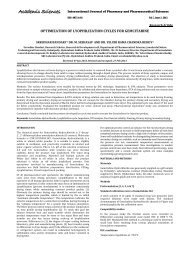formulation, optimization and evaluation of clobetasol propionate gel
formulation, optimization and evaluation of clobetasol propionate gel
formulation, optimization and evaluation of clobetasol propionate gel
You also want an ePaper? Increase the reach of your titles
YUMPU automatically turns print PDFs into web optimized ePapers that Google loves.
Verma et al.<br />
Int J Pharm Pharm Sci, Vol 5, Issue 4, 666-674<br />
with continuous stirring. The pH <strong>of</strong> the <strong>gel</strong>s was brought to skin pH<br />
by TEA. The final weight <strong>of</strong> the <strong>gel</strong> was adjusted to 50 grams with<br />
distilled water. The <strong>gel</strong>s were stored in wide mouthed bottles.<br />
Entrapped air bubbles were removed by keeping the <strong>gel</strong>s in vacuum<br />
oven for 2 hours. The composition <strong>of</strong> various <strong>gel</strong> <strong>formulation</strong>s is<br />
shown in Table No.2<br />
Optimisation <strong>of</strong> Gel <strong>formulation</strong><br />
The experimental design was a two factor three level (3 2 ) full<br />
factorial design (FD) <strong>and</strong> nine <strong>formulation</strong>s were prepared. The<br />
amount <strong>of</strong> polymers X1 (HPMC K4M) <strong>and</strong> X2 (carbopol -934) were<br />
selected as independent variables. The amount <strong>of</strong> polymers was<br />
optimised for dependent variables: Drug release after 8 hours <strong>and</strong><br />
viscosity <strong>of</strong> <strong>gel</strong>s. The low (-1), medium (0) <strong>and</strong> high (1) are the<br />
values <strong>of</strong> X1 (HPMC K4M) <strong>and</strong> X2 (carbopol -934) respectively. Nine<br />
batches were formulated as shown in Table 2. In a full FD, all the<br />
factors are studied in all possible combinations, as it is considered to<br />
be most efficient in estimating the influence <strong>of</strong> individual variables<br />
<strong>and</strong> their interaction using minimum experimentation. In the<br />
present study the responses were analysed for ANOVA using design<br />
expert s<strong>of</strong>tware (trial version 8.0.7). A mathematical equation was<br />
generated for each parameter. The mathematical model was studied<br />
for significance. Response surface plots were generated for each<br />
response to study the behaviour <strong>of</strong> the system.<br />
Generation <strong>of</strong> statistical models<br />
A statistical model, Y= incorporating interactive <strong>and</strong> polynomial<br />
terms was used to evaluate the responses; where Y is the dependent<br />
variable, is the arithmetic mean response <strong>of</strong> the nine runs <strong>and</strong> is the<br />
estimated coefficient for the factor X. The main effects (X1 <strong>and</strong> X2)<br />
represent the average result <strong>of</strong> changing one factor between two<br />
factors.<br />
Optimum <strong>formulation</strong> for topical <strong>gel</strong> <strong>of</strong> <strong>clobetasol</strong> <strong>propionate</strong><br />
Gels were prepared as method described earlier. The composition <strong>of</strong><br />
optimized <strong>formulation</strong> (F10) <strong>of</strong> the <strong>gel</strong> is tabulated in Table 8.<br />
Development <strong>of</strong> optimized topical <strong>gel</strong><br />
The optimized <strong>gel</strong> was prepared with the best amount <strong>of</strong> polymers<br />
suggested by the design expert s<strong>of</strong>tware (demo version 8.0.7). The<br />
prepared <strong>gel</strong>s were evaluated for its physiochemical properties viz.<br />
Homogeneity, grittiness, spreadability, viscosity, Ph measurement,<br />
drug content <strong>and</strong> In-vitro drug diffusion studies. The procedures for<br />
the above mentioned properties are described below. The results<br />
are shown in Table 8 <strong>and</strong> 9.<br />
Evaluation <strong>of</strong> Gels<br />
A. pH Measurement [11]<br />
The pH <strong>of</strong> various <strong>gel</strong> <strong>formulation</strong>s was determined by using digital<br />
pH meter.1 g <strong>of</strong> <strong>gel</strong> was dissolved in 100 mL freshly prepared<br />
distilled water <strong>and</strong> stored for two hours. The measurement <strong>of</strong> pH <strong>of</strong><br />
each <strong>formulation</strong> was done in triplicate <strong>and</strong> average values are<br />
calculated.<br />
B. Homogeneity [12]<br />
All developed <strong>gel</strong>s were tested for homogeneity by visual inspection<br />
after the <strong>gel</strong>s have been set in the container.<br />
C. Grittiness [13]<br />
Smears <strong>of</strong> <strong>gel</strong>s were prepared on glass slide <strong>and</strong> observed under the<br />
microscope for the presence <strong>of</strong> any particle or grittiness.<br />
D. Viscosity Measurement [12, 14]<br />
Brookfield digital viscometer was used to measure the viscosity <strong>of</strong><br />
prepared <strong>gel</strong> <strong>formulation</strong>s. The spindle no. 6 was rotated at 10 rpm.<br />
The reading, near to 100 % torque was noted. Samples were<br />
measured at 30 ± 1 °C.<br />
E. Spreadability [15]<br />
One <strong>of</strong> the criteria for a <strong>gel</strong> to meet the ideal quantities is that it<br />
should possess good spreadability. It is the term expressed to<br />
denote the extent <strong>of</strong> area to which <strong>gel</strong> readily spreads on<br />
application. The therapeutic efficacy <strong>of</strong> a <strong>formulation</strong> also depends<br />
upon its spreading value. It was determined by wooden block <strong>and</strong><br />
glass slide apparatus. Weights <strong>of</strong> about 2 g were added to the pan<br />
<strong>and</strong> the time was noted for upper slide (movable) to separate<br />
completely from the fixed slides. Spreadability was then calculated<br />
by using the formula:<br />
S = M.L / T<br />
Where,<br />
S = Spreadability<br />
M = Weight tide to the upper slide<br />
L = Length <strong>of</strong> a glass slide<br />
T = Time taken to separate the slide completely from each other.<br />
F. Drug content [16, 17]<br />
A specific quantity (1 g) <strong>of</strong> developed <strong>gel</strong> was taken <strong>and</strong> dissolved in<br />
100mL <strong>of</strong> phosphate buffer <strong>of</strong> pH 7.4. The volumetric flask containing<br />
<strong>gel</strong> solution was shaken for 2 h on mechanical shaker in order to get<br />
complete solubility <strong>of</strong> drug. The solution was filtered through 0.45 μm<br />
membrane filter <strong>and</strong> estimated spectrophotometrically at 293 nm<br />
using phosphate buffer (pH 7.4) as blank.<br />
G. In-vitro Drug Diffusion Study [18]<br />
In-vitro drug release studies were performed by using a modified<br />
Franz diffusion cell with a receptor compartment capacity <strong>of</strong> 20 ml.<br />
The synthetic cellophane membrane was mounted between the<br />
donor <strong>and</strong> receptor compartment <strong>of</strong> the diffusion cell. The<br />
formulated <strong>gel</strong>s were weight up to 1 g <strong>and</strong> placed over the drug<br />
release membrane <strong>and</strong> the receptor compartment <strong>of</strong> the diffusion<br />
cell was filled with phosphate buffer pH 7.4. The whole assembly<br />
was fixed on a magnetic stirrer, <strong>and</strong> the solution in the receptor<br />
compartment was constantly <strong>and</strong> continuously stirred using<br />
magnetic beads at 50 RPM; the temperature was maintained at 37 ±<br />
0.50 °C. The samples <strong>of</strong> 1 mL were withdrawn at time interval <strong>of</strong> 30,<br />
60, 90, 120, 150, 180, 210, 240, 270, 300, 330, 360, 390, 420, 450<br />
<strong>and</strong> 480 minutes <strong>and</strong> analysed for drug content<br />
spectrophotometrically at 240 nm against blank. The receptor phase<br />
was replenished with an equal volume <strong>of</strong> phosphate buffer at each<br />
time <strong>of</strong> sample withdrawal. The cumulative amounts <strong>of</strong> drug<br />
diffused from <strong>gel</strong>s were plotted against time.<br />
Mechanism <strong>of</strong> Drug Release [19]<br />
Various models were tested for explaining the kinetics <strong>of</strong> drug<br />
release. To analyse the mechanism <strong>of</strong> the drug release rate kinetics<br />
<strong>of</strong> the dosage form, the obtained data were fitted into zero-order,<br />
first order, Higuchi, Hixon- Crowell model <strong>and</strong> Korsmeyer-Peppas<br />
release model.<br />
Zero order release rate kinetics<br />
To study the zero–order release kinetics the release rate data are<br />
fitted to the following equation.<br />
F = K0.t………………………….…………………………………...... (Eq. 1)<br />
Where ‘F’ is the drug release, ‘K0’ is the release rate constant <strong>and</strong> ‘t’<br />
is the release time. The plot <strong>of</strong> percentage drug release versus time<br />
is linear.<br />
First order release rate kinetics<br />
The release rate date are fitted to the following equation<br />
Log (100 – F) = K t…………………………………………..……. (Eq. 2)<br />
A plot <strong>of</strong> log % drug release versus time is linear.<br />
Higuchi release model<br />
To study the Higuchi release kinetics, the release rate data were<br />
fitted to the following equation, where, ‘k’ is the Higuchi constant. In<br />
higuchi model, a plot <strong>of</strong> percentage drug release versus square root<br />
<strong>of</strong> time is linear.<br />
667



